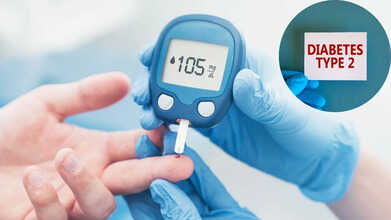- Health Conditions A-Z
- Health & Wellness
- Nutrition
- Fitness
- Health News
- Ayurveda
- Videos
- Medicine A-Z
- Parenting
- Web Stories
Are People Too Busy To Take Care Of Their Own Health? Study Finds Lack Of Check-ups Increase Chances Of This Eye Condition

(Credit-Canva)
“Health is Wealth” is something we all teach our kids so that they learn to put themselves first, however many times they fail to learn it as we ourselves do not follow it.
While we are constantly urged to take care of our health above anything else, it is a message not many of us take seriously. Many people in the UK are putting their health on the back burner, claiming they're simply too busy.
A recent study reveals that one in five Brits are neglecting their own well-being, often skipping important appointments like eye exams, dental visits, and doctor's check-ups. In fact, three-quarters of people have either missed or postponed a health appointment because their schedules were too packed.
Why Are We So Busy?
The main culprits for these missed appointments seem to be work demands and childcare responsibilities. On top of that, the sheer stress of arranging the appointments themselves is another big reason adults avoid necessary blood tests or eye exams. This research, commissioned by Specsavers for Glaucoma Awareness Week, aims to shed light on glaucoma, often called the "silent thief of sight."
What is Glaucoma?
Glaucoma refers to a group of eye diseases that can lead to vision loss and even blindness. It does this by harming your optic nerve, which is like a cable at the back of your eye that sends images to your brain.
The tricky part about glaucoma is that its symptoms often begin so slowly you might not even notice them. This is why it's often called the "silent thief of sight." The only way to truly find out if you have it is by getting a thorough eye exam where your pupils are dilated.
While there's no cure for glaucoma, catching it early and starting treatment can often stop the damage and help protect your vision from getting worse.
Don't Wait for Symptoms
A spokesperson highlighted that it's easy to push check-ups aside when you feel fine and life is hectic. However, conditions like glaucoma can develop slowly without any noticeable symptoms. By the time you notice an issue, "irreversible damage" might have already occurred. That's why it's crucial not to wait for symptoms to appear; regular check-ups can help protect your long-term health.
Initially, glaucoma usually has no noticeable symptoms. This is a big reason why about half of the people who have it don't even know it.
Over time, you might slowly start to lose your vision. This often begins with your side (peripheral) vision, especially the part closest to your nose. Because this happens so gradually, many people don't realize their vision is changing at first. As the disease worsens without treatment, you may begin to notice significant blind spots and, eventually, it can lead to complete blindness.
Simple Tasks Often Overlooked
The study also found that busy adults often neglect other simple health tasks due to lack of time. These include getting a full night's sleep or drinking enough water. A significant number of people (one-fifth) admitted they've been so focused on work that they haven't taken proper screen breaks or even moved from their seats for long periods.
Among those who don't prioritize their own health, 28% put their children's needs first, while 19% prioritize housework. Sadly, over a third confessed that only a health scare or a clear symptom would finally push them to book a delayed check-up. Many understand the need for appointments but find them easy to forget.
Making Health a Priority
Many Brits believe that easier booking systems (four in ten) or simply more time in their day (a third) would help them focus more on their health. Specsavers emphasized that even though schedules are busy, ignoring eye care isn't an option. A quick eye check every couple of years can protect you from serious long-term problems. Your vision is incredibly valuable and deserves your attention.
Blood Sugar Levels In Type 2 Diabetes: What Counts As High, Low, Or Normal?

Credits: Canva
Type 2 diabetes is a long-term condition where your body either doesn’t produce enough insulin or can’t use the insulin it makes properly, causing blood sugar levels to rise. Keeping an eye on your blood sugar is essential for managing the condition and protecting your overall health.
A blood sugar chart can help you understand what’s normal, too high, or too low. By getting familiar with these ranges, you can work with your doctor to maintain healthy levels and reduce the risk of complications. Below, we break down everything you need to know about type 2 diabetes.
What is Type 2 diabetes?
Type 2 diabetes (T2D) occurs when blood sugar (glucose) remains consistently high. Normal blood sugar levels fall between 70 and 99 milligrams per deciliter (mg/dL). If undiagnosed, Type 2 diabetes often shows levels of 126 mg/dL or more.
T2D happens because the pancreas doesn’t produce enough insulin, the body can’t use insulin effectively, or a combination of both. This differs from Type 1 diabetes, which arises when the immune system attacks the pancreas, leaving the body unable to produce insulin at all.
How Common Is Type 2 Diabetes?
Type 2 diabetes is widespread. Over 37 million people in the U.S. have diabetes (around 1 in 10), with 90–95% of cases being T2D. Globally, it affects roughly 6.3% of the population. While it’s most common in adults over 45, younger adults and even children can develop it.
Blood Sugar Range For Adults With Type 2 Diabetes And Children With Type 2 Diabetes
The American Diabetes Association recommends the following ranges for adults with type 1 or type 2 diabetes and children with type 2 diabetes:
| Time | Recommended Blood Sugar Range |
| Fasting (before eating) | 80 to 130 mg/dL |
| 1 to 2 hours after meal | Lower than 180 mg/dL |
Is Type 2 Diabetes Genetic?
T2D has complex causes, but genes play a significant role. If one biological parent has T2D, your lifetime risk is around 40%, and if both parents do, it rises to 70%. Scientists have identified over 150 DNA variations linked to T2D risk, some increase the chance of insulin resistance or reduced insulin production, while others influence obesity risk. These genetic factors interact with lifestyle and health habits to determine overall risk.
How is Type 2 Diabetes Diagnosed?
Doctors use several blood tests to confirm T2D:
- Fasting plasma glucose test: Measures blood sugar after an eight-hour fast. A result of 126 mg/dL or higher indicates diabetes.
- Random plasma glucose test: Measures blood sugar at any time without fasting. A reading of 200 mg/dL or higher signals diabetes.
- A1C test: Reflects average blood sugar over the past 2–3 months. A level of 6.5% or higher indicates diabetes.
What Is A1C?
A1C shows your average blood sugar for the past three months. When sugar circulates in your blood, it attaches to a protein called hemoglobin. Higher blood sugar levels result in a higher percentage of hemoglobin coated with sugar. Your A1C result helps indicate whether your blood sugar is normal, prediabetic, or diabetic.
The chart below shows where your A1C result stands, whether it is within a healthy range or could indicate prediabetes or diabetes.
| Diagnosis | AIC Result |
| Normal | less than 5.7% |
| Prediabetes | between 5.7% and 6.4% |
| Diabetes | 6.5% and higher |
Not All Antidepressants Affect Your Body The Same; Here’s What You Need To Know About Side Effects

Credits: Canva
Antidepressants side effects: Anyone who has been prescribed medication for depression knows the long list of possible side effects: fatigue, appetite changes, headaches, and more. But these physical reactions are not the same across all medications. Recent research shows that some antidepressants can cause quick changes in weight, heart rate, and blood pressure, while others are relatively mild. The purpose of this work was to rank antidepressants based on their known side effects, specifically those that appear within the first eight weeks of starting treatment.
What Are Antidepressants?
Antidepressants are prescription medications used to treat conditions like depression, anxiety, chronic pain, and more by boosting brain chemicals that regulate mood. Common types include SSRIs, SNRIs, and NDRIs. They often take several weeks to show full effect. Typical side effects can include dry mouth, weight changes, and dizziness. Interestingly, new research suggests that the side effect profile can vary depending on the specific antidepressant.
Also Read: Why Do I Get Bad Dreams When I Am Sick?
Types of Antidepressants
There are several categories of antidepressant medications, as per NHS:
- Selective serotonin reuptake inhibitors (SSRIs): Increase serotonin levels in the brain to improve mood.
- Serotonin-norepinephrine reuptake inhibitors (SNRIs): Raise both serotonin and norepinephrine, helping with mood, alertness, and stress.
- Tricyclic antidepressants: Affect serotonin and norepinephrine like SNRIs, but also influence other parts of the body and brain.
- Monoamine oxidase inhibitors (MAOIs): Boost brain chemical levels by blocking an enzyme that breaks them down.
- NMDA receptor antagonists: Work quickly to improve mood by targeting specific brain receptors, usually given in clinics if other medications fail.
- Atypical antidepressants: Don’t fit neatly into other groups, each affecting brain chemicals in unique ways.
Physical Side Effects Differ Across Antidepressants
Millions of adults in the U.S. rely on antidepressants for conditions such as depression and anxiety. Like all medications, these drugs can cause side effects, though the severity varies. Researchers from King’s College London and the University of Oxford examined just how differently side effects appear across 30 antidepressants, analyzing data from over 58,500 participants in more than 150 studies.
“Not all antidepressants are the same when it comes to their physical side effects,” explained Toby Pillinger, an academic clinical lecturer at King’s College London. The findings, published in The Lancet, are the first to link specific physical side effects to individual antidepressants, offering potentially important guidance for doctors prescribing these medications, which are taken by up to 17% of adults in Europe and North America.
Drugs reviewed included SSRIs like sertraline (Zoloft) and fluoxetine (Prozac), SNRIs like duloxetine (Cymbalta) and venlafaxine (Effexor), and NDRIs like bupropion (Wellbutrin).
Antidepressants Side Effects
The research looked at 30 commonly prescribed antidepressants across 151 studies involving over 58,500 patients. Not everyone develops side effects, but on average:
- Eight weeks of agomelatine use linked to a 2.4kg weight loss, whereas maprotiline led to nearly 2kg weight gain.
- Heart rate varied by 21 beats per minute between fluvoxamine, which slowed the heart, and nortriptyline, which sped it up.
- Blood pressure differed by 11 mmHg between nortriptyline and doxepin.
Antidepressants: Effects on Heart Rate and Blood Pressure
Some medications, like fluoxetine, were linked to increased systolic blood pressure, while others, like citalopram (Celexa), were not. Citalopram was associated with slight weight loss, decreased heart rate, and systolic blood pressure, with a minor rise in diastolic blood pressure. Venlafaxine raised heart rate, while paroxetine (Paxil) caused no heart rate changes.
“Clearly, no two antidepressants affect the body in the same way,” said Dr. Atheeshaan Arumuham from King’s College London.
Interestingly, commonly prescribed antidepressants in the U.S., such as fluoxetine, bupropion, and sertraline, were linked to weight loss over the short-term in these trials. For reference, about 1.4 million people were prescribed citalopram last year.
Antidepressants: Short-Term or Long-Term Side Effects?
A limitation of this research is that the studies analyzed were relatively short, with a median treatment duration much shorter than most real-world use. It also did not assess other common side effects, including sexual dysfunction, headaches, upset stomach, and, in rare cases, agitation or suicidal thoughts. Since the focus was on the first eight weeks, further research is needed to understand long-term effects.
Choosing the Right Antidepressant
As side effects differ across medications, there is no one-size-fits-all solution. Dr. Pillinger advises that selecting the right antidepressant should always be done in consultation with a qualified medical professional.
Delhi Air Pollution: AQI Crosses 400, Experts Warn of Rising Heart Problems

Credits: Canva
Delhi woke up under a thick blanket of haze on Tuesday, October 21, just a day after millions celebrated Diwali with fireworks, signalling the start of yet another pollution season that grips the city every winter.
Residents of what is already the most polluted capital in the world were once again forced to breathe toxic air, classified under the “severe” category. In several parts of the city, the Air Quality Index (AQI) climbed beyond 500, about ten times higher than what the World Health Organization considers safe. In some areas, the concentration of PM2.5 and PM10 particles hit alarming peaks of around 1,800, fifteen to twenty times higher than healthy limits.
While we often link these conditions to respiratory problems, experts say the damage extends to the heart as well. To understand this connection, we spoke with Dr Manav Manchanda, Director & Head of Respiratory, Critical Care and Sleep Medicine at Asian Hospital.
How Does Air Pollution Affect The Heart?
An AQI of 400 or more means the air is loaded with fine dust, toxic gases, and heavy metals, levels so high they can strain even healthy lungs and hearts. What was once seen as a seasonal nuisance has now turned into a slow-moving public health crisis affecting millions across Delhi and other northern cities where winter smog pushes AQI readings into the danger zone.
These microscopic pollutants (PM2.5 and PM10) bypass the body’s natural filters in the nose and throat and reach deep into the lungs, settling in the bronchi and alveoli, the small air sacs responsible for oxygen exchange. The result is inflammation, oxidative stress, and swelling of the airways, often accompanied by excess mucus. Even healthy individuals may experience throat irritation, chest discomfort, or a persistent cough.
But the harm does not stop at the lungs. According to Dr Manchanda, “Once particulate matter enters the bloodstream, it circulates through the body and causes inflammation in the blood vessels.” Over time, this inflammation stiffens the arteries, raises blood pressure, and can trigger irregular heart rhythms. Research has shown that even short-term exposure to severe pollution can increase the risk of heart attacks and strokes, particularly in those already prone to heart disease.
For healthy adults, this exposure can still cause fatigue, palpitations, or a faster resting heart rate as the body compensates for reduced oxygen intake.
What Short-Term Symptoms Should You Watch For Amid High AQI Levels?
During periods of poor air quality, experts recommend being alert to subtle but important warning signs. Common short-term symptoms include a dry cough, sore throat, breathlessness while climbing stairs, chest pain, watery eyes, or persistent headaches. Many also experience tiredness or dizziness because of reduced oxygen supply. These may appear mild but are early signs of inflammation and air toxicity.
To minimise risk, use an N95 or N99 mask before stepping out, avoid exercising outdoors when pollution levels peak, and consider using an indoor air purifier. Regular lung and heart screenings should no longer be limited to people with existing conditions.
Who Is More Vulnerable to Heart Diseases During High AQI?
According to the US Environmental Protection Agency, the groups most at risk include children, older adults, pregnant women, individuals with existing heart or lung conditions, and people from economically weaker sections. These populations are more vulnerable due to developing or aging organs, compromised immunity, and higher exposure to pollution, especially among those living near traffic or using solid fuels for cooking and heating.
How to Protect Yourself From Air Pollution?
1. Track AQI updates using apps like AQI India or AirVisual, or visit the Central Pollution Control Board’s website. On days when AQI levels exceed 200 (considered poor), avoid unnecessary outdoor activity.
2. Get a good air purifier, preferably one with a HEPA filter can help reduce these toxins. Place purifiers in rooms where you spend the most time, such as your bedroom or living area. If multiple devices are not an option, create a single “clean air zone” in one part of your home.
3. In today’s pollution levels, masks are no longer optional. Choose N95 or N99 masks, which are specifically designed to block PM2.5 particles, the same ones responsible for thousands of deaths each year.
4. Certain indoor plants, like peace lilies, areca palms, and snake plants, can help reduce indoor pollutants naturally. While they can’t replace purifiers, they contribute to better air quality and bring a touch of calm to your space.
5. During severe smog, stay indoors as much as possible. If you need to step out, try to do so in the afternoon when pollution tends to ease slightly. Avoid mornings and late evenings, when toxic particles linger close to the ground.
6. Include antioxidant-rich foods such as nuts, berries, and leafy vegetables to fight the oxidative damage caused by pollution. Omega-3 fatty acids from fish or flaxseeds are also beneficial for heart and lung health.
Drink plenty of water throughout the day as it helps flush out toxins, including those inhaled from polluted air.
© 2024 Bennett, Coleman & Company Limited

